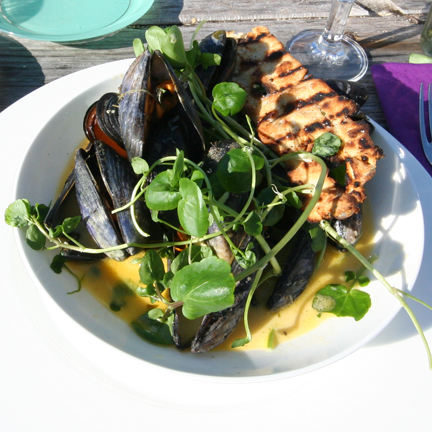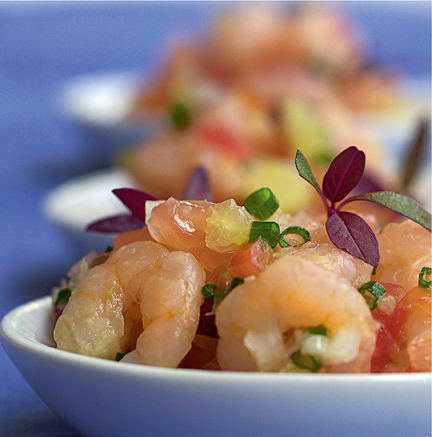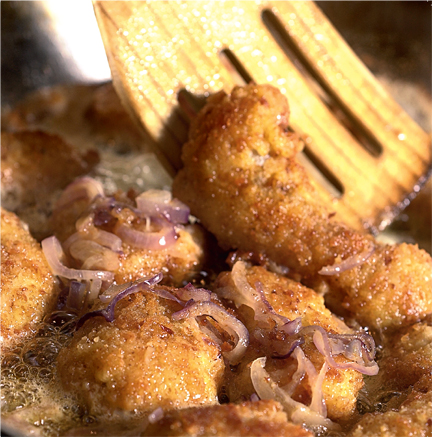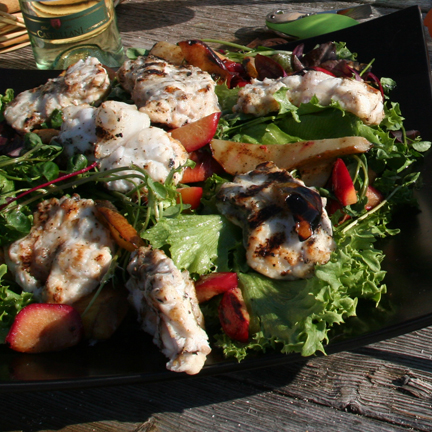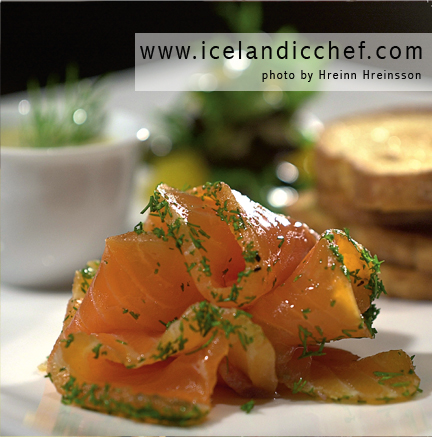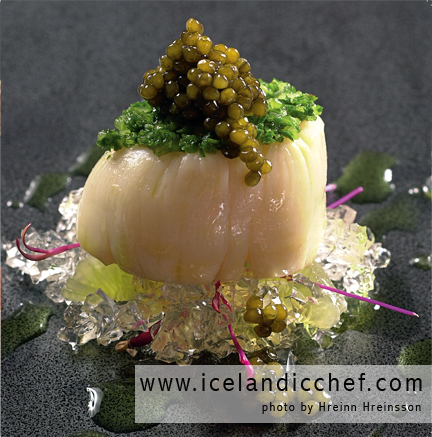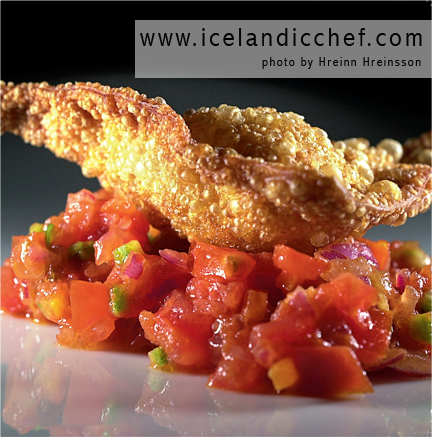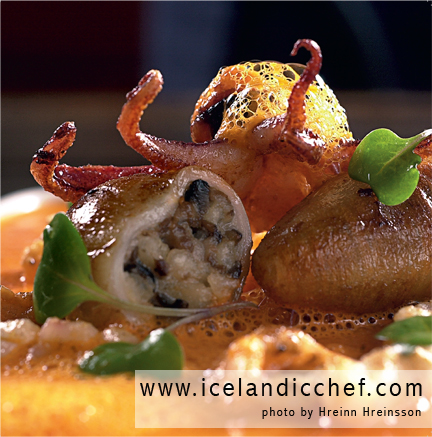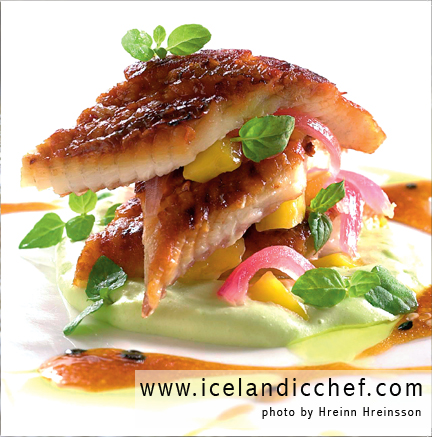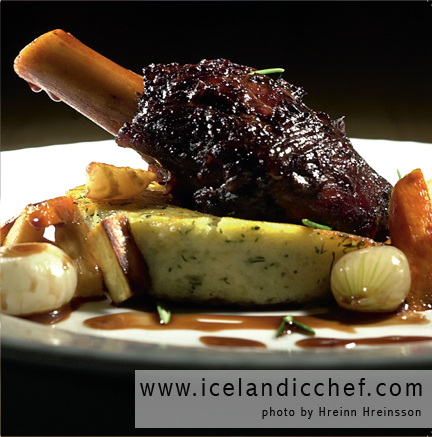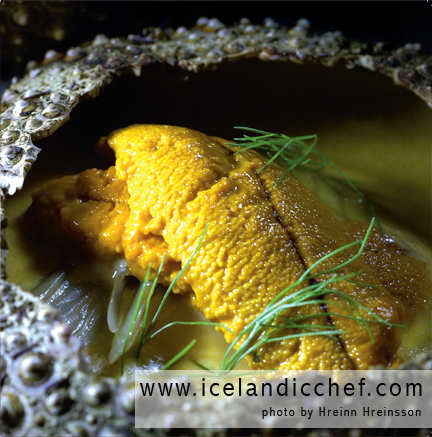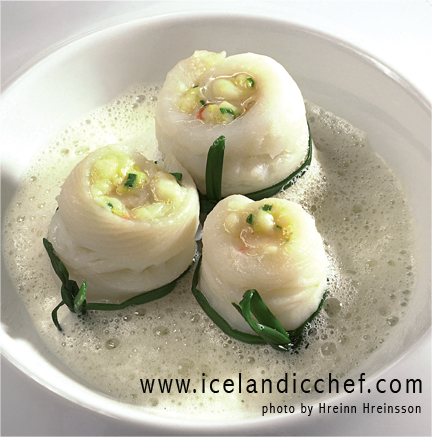STEAMED PLAICE with Plaice and Shrimp Soufflé and Hollandaise sauce
(Serves four)
12 small fillets of plaice
12 chives
2 cups dry white wine
½ lb of plaice (use the ends and trimmings of the plaice fillets)
½ lb Icelandic shrimps
2 tablespoons shallot onion, finely diced
2 tablespoons brandy
1 tablespoon tomato paste
½ cup egg whites
¾ cup whipping cream
Salt and pepper
For the soufflé, first put the plaice trimmings, the shrimps, the brandy and the tomato paste into a food processor and blend these ingredients until they have become a smooth paste. Now add the egg whites and blend on until they are thoroughly mixed in. When this is done, transfer the mixture into a bowl and chill it for about thirty minutes. When the chilling time is up, fold the chopped onions in with the mixture and then the cream until these are fully incorporated. Season the mixture to taste with salt and pepper and put it into a piping bag.
Now season the fillets of plaice with salt and pepper. Roll up each fillet length-wise into a cylinder, leaving a hole about an inch in diameter in the center. Fill the hole with the soufflé, using the piping bag. Finally, tie a string of chive around the roll to hold it together. Finish rolling and filling all twelve rolls.
Now choose a very wide pot. Pour the white wine into the pot and then put a rack into it. The rack should be well above the surface of the white wine, and large enough to accommodate all the rolls. To get the required height for the rack, it can be put on top of, for example, some upended, small coffee cups. Place the rolls on the rack. They should not touch one another. The heat is turned on, the pot covered and the white wine let boil for about one minute and then the heat turned off. The pot is left on the stove for about five minutes, then the heat is turned on again and the wine let boil for about one minute more. After this the heat is again turned off, and the rolls left in the pot for about two minutes, after which time they should be ready.
Hollandaise Sauce
4 egg yolks
1¼ cup butter
Salt and pepper to taste
Juice of ½ – 1 lemon
Beat the egg yolks until they are light colored. Heat the butter in a small sauce pan and keep it hot but do not let it bubble. Keep beating the egg yolks and very slowly pour in a bit of hot butter. Let it emulsify, then add some more, then a bit more until the butter is gone. Season to taste with salt, pepper and lemon juice, and keep it in a warm spot or you can keep it in a thermo cup.
FRESH SCALLOP CEVICHE with Mango, Chili & Tomatoes marinated in Coriander and Citrus Juices. (Serves 4)
14 oz / 400 g fresh scallop with the roe
6 small radish, sliced
2.5 oz / 70 g red onion, finely chopped
2 tbs red chili, finely chopped
2 tomatoes, medium size
½ mango, diced
Juice of ½ lemon
Juice of ½ lime
Juice of 1 orange
1.4 oz / 40 ml rice vine vinegar
2 tbs fresh chopped coriander
Salt to taste
Fresh white pepper to taste
Open up the shell and take out the scallop, put it in a bowl along with the roe, slice up some radish, red onion, chili, mango and tomatoes and put it in the bowl with the scallop. Then take the lime, orange and lemon and squeeze the juice over the mixture of ingredients already in the bowl.
Next, pour the rice wine vinegar over the ingredients and add some white pepper and a dash of salt according to taste. Chop up the fresh Coriander and add, and mix together. Put the ceviche in a jar or on a plate and leave it on ice or in a refrigerator to marinade properly for about 90 minutes.
LIGHT BEER STEAMED MUSSLES with Ginger, Garlic & Jalapeno served in its own thyme infused creamy broth. (Serves 4)
2.5 lb mussels
1 red onion, chopped
8 garlic cloves, diced
4 tbs ginger, diced
1 tbs jalapeno
1 red bell pepper, diced
4 tomatoes, diced
1 bunch fresh thyme
7 oz / 200 g butter
8.5 fl. oz / 250 ml heavy cream
1 light beer
Start by dicing the ginger, red onion, jalapeno, sweet red bell pepper and tomatoes. Put all the ingredients on top of the mussels in a large bowl and then add the thyme. Mix well together and put in a large pot. Next you add the butter and then pour in the light beer and the cream. Steam for three to five minutes.
CITRUS SHRIMP SALAD
(Serves four)
12 oz shrimps
½ onion
½ avocado
1 blood orange, segmented and diced
1 grape fruit, segmented and diced
1 tablespoon chives, chopped
1½ tablespoons quality sesame seed oil
Pinches of red orach for decor
For this salad chop the onion, avocado, blood orange, and grapefruit segments into small cubes. Mix thoroughly with the shrimps, sesame seed oil and chives. Care must be taken not to crush the avocado cubes, as they tend to be somewhat soft. Because of this, it may be advisable to add the avocado only when all the other ingredients have been mixed together, gently folding it in. Season the mixture to taste with salt and pepper. This dish is really fine for starters. It is served in rather small portions and therefore ideally in small vessels, such as Chinese porcelain spoons, which can contain the appropriate amount of salad and are also very satisfying to the eye. Sprinkle a pinch of red orach on top for décor.
PAN-SAUTÉED HADDOCK with caramelized lime, sautéed onions and potatoes
(Serves four)
1.5 lb fillet of haddock, skinned
1 red onion, sliced
4 oz butter
½ cup flour
2 eggs
1 cup bread crumbs
2 limes
2 tablespoons sugar
Salt and pepper
Trim the skinned fillet of haddock and cut it into pieces about two to three inches in width. Roll the pieces in flour seasoned with some salt and pepper, immerse in beaten eggs and finally coat the fillet pieces thoroughly in bread crumbs. Sauté the prepared pieces of fillet in butter in a medium hot pan until they are golden brown and the bread-crumb crust has become somewhat crispy.
Sauté the slices of red onion in the pan along with the fillets. Cut the lime in half, dip it in sugar and sauté it in butter in a separate pan (cut side down) until the sugar has caramelized.
To serve place the fillet of haddock on top. Rest the caramelized lime on the fillet. Its juice is to be squeezed on the fillet when it is eaten. Ladle some of the butter and sautéed onions from the pan the fillets were sautéed in on top of the arrangement, keeping some on the side along with the potatoes.
GRILLED MONK FISH marinated in Chef Volli´s BBQ sauce on top of fresh tomato, arugula and couscous salad with chunky cucumber and “Skyr” raita.
(Serves 4)
MONK FISH
4 steaks of monk fish each approx. 6.5 (oz) / 185 (g)
Marinade the monk fish steaks in the BBQ sauce for 10 min up to an hour. Grill the steaks on a medium hot grill, allowing 10 minutes per inch of thickness or until the meet is firm. Turn once halfway through cooking time. Baste frequently during cooking and once after taking the monk fish of the grill.
“SKYR” RAITA
2 cucumbers, peeled and diced
1 tsp kosher salt
2 cups Icelandic Skyr or (plain whole milk yogurt)
1 tbs freshly squeezed lemon juice
2 tsp finely chopped garlic
2 tsp cumin seeds
To make the raita: Place the cumin seeds in a large dry skillet over medium heat. Stir for 2 minutes until fragrant. Remove to a plate and cool. Place in a spice grinder (or clean coffee grinder) and grind well. In a medium bowl, combine the cucumbers and the salt. Mix well and let sit for 15 to 30 minutes, then drain. Add the ground cumin seeds, yogurt, lemon juice and garlic and mix to combine. Let sit for 10 minutes. Chill until ready to serve.
COUSCOUS with fresh tomatoes and arugula salad.
1 cup couscous
1¼ cups water
1 tsp balsamic vinegar
½ tsp of salt
½ tsp fresh ground white pepper.
1 tbs olive oil
1 cup diced tomatoes
1 cup arugula
Bring the liquid to boil with salt, pepper, balsamic vinegar and the olive oil. Then add in the couscous. When the mixture is boiling, take it off the heat immediately. Cover and let sit for about 5 minutes, then mix in the diced tomatoes and arugula.
CHEF VOLLI´S BARBEQUE SAUCE (makes about 1½ cups)
1 tbs dried oregano
1 tbs paprika
2 cloves, garlic, chopped fine
1 tsp fresh chili pepper, chopped fine
4 whole fresh cloves
1 whole black peppercorn
2 tbs whole mustard seeds
2 star anis
1 tsp all spice
1 tsp coriander
1 tbs fresh ginger, copped
1 tsp cayenne pepper
1 small bay leaf
Put the above dry ingredients in a hop pot and stir well for one minute to bring out the flavor of all the spices.
¾ cup ketchup
2 tbs Worcestershire sauce
½ cup water
6 tbs red wine vinegar
3 tbs Soy sauce
1 tbs brown sugar
After having heated the dry ingredients above in the pot, add the vinegar and the soy sauce and bring to a boil. Now, add the rest of the ingredients, cover the pot and simmer its contents for one hour. Then strain the mixture and thin out with water if needed.



